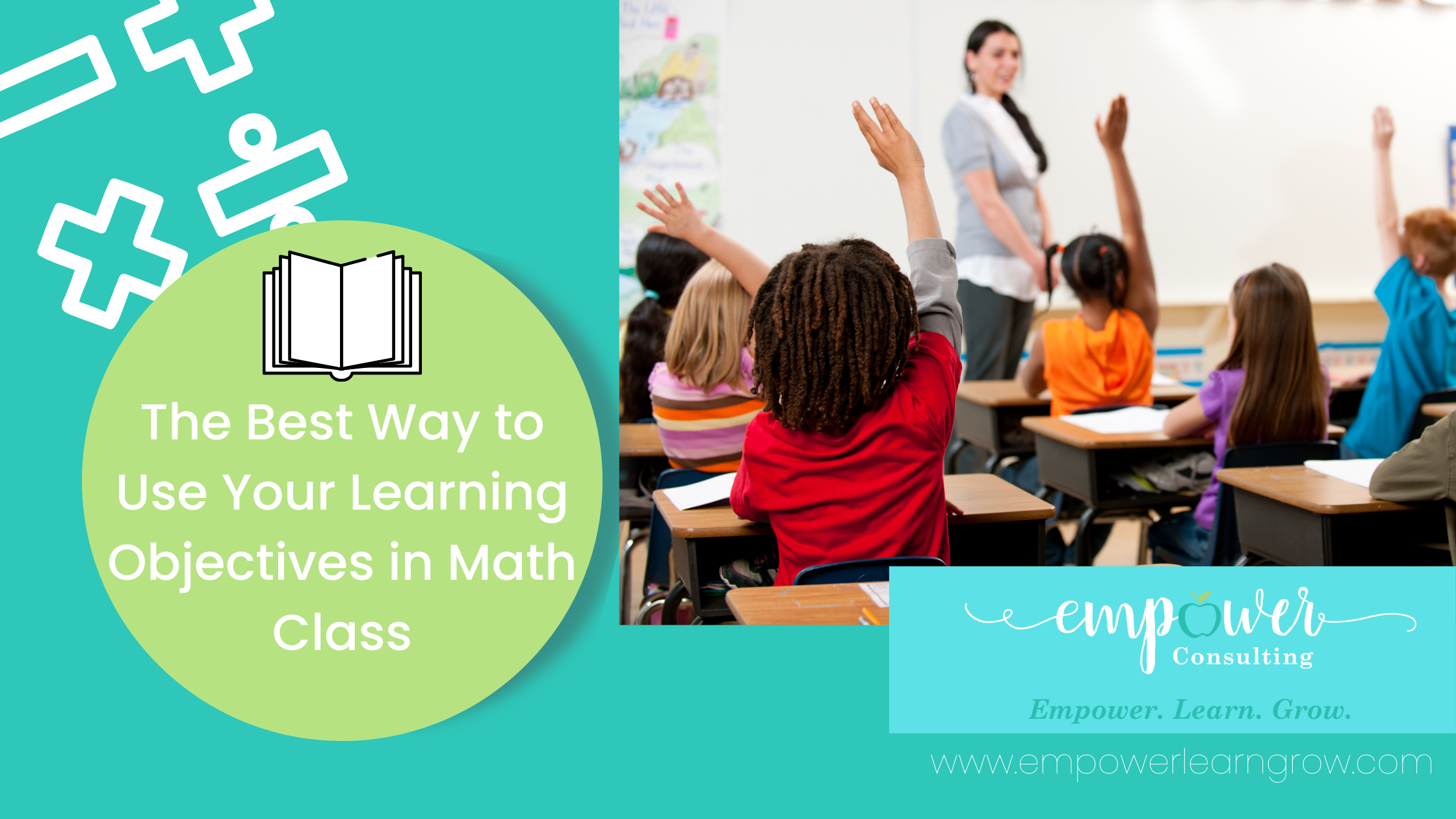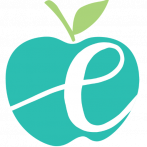
24 Aug The Best Way to Use Your Learning Objectives in Math Class
Your learning objectives are killing your learning.
Yes, I said it, but before you call the math police, hear me out.
Posting or showing your students the math objective for the day is not helping your lesson. It’s actually hurting your students’ learning.
I find that math teachers are posting their learning objectives because it is part of what is expected of them. Administrators are expecting to see the objectives posted, so they post it.
However, I have seen how reading or reciting the learning objective can completely kill off a student’s curiosity and hinder their learning.
Now, I am not arguing about the purpose of the learning objectives. I understand they are necessary. What I am arguing is when, why, and how we use them. Simply posting an objective does not mean it is positively impacting learning. I’d say, it is doing the complete opposite.
Here are a few issues I see with the posted objectives in classrooms:
- They are too long: the objectives are so verbose and filled with complex language that even I have to read them a few times to understand- and I am an adult!
- They are written in “I can…,” or SWBAT (Students will be able to..) statements: the objectives are not comprehensive of the expectation of learning. They rarely change from day to day.
- They are not referenced throughout the lesson: the objectives are mentioned at the beginning of the math lesson and then never again.
- Students recite them: there is no discussion of the objectives. Students are only reading them off of the board and moving onto the lesson.
- Posting, reading, or reciting objectives gives away learning!
I know they are a best instructional practice and part of your teacher evaluation, but we need to use them in better ways that contribute to our students’ learning.
I once taught a basil reading series that required “Focus Walls.” These focus walls became mandatory for all teachers to have in their classrooms. Posted on each wall were materials from the curriculum including, you guessed it, the learning objectives! These bulletin boards required so much upkeep that teachers were staying late Friday evenings or even coming in on Sundays just so they would be ready for instruction on Monday. I don’t believe we were trained well enough on the ‘why’ to the point where we owned the idea and believed in their purpose.
Could they improve learning? Sure. But for most, they were just decoration intended for those doing the walkthroughs. They weren’t being utilized during the lessons. They weren’t improving education. When we don’t understand the ‘why’ we become compliant. When we become compliant, we’ve missed the point completely. It’s true for us and it’s true for our students.
As a person ON those administrative walkthroughs in my later teaching years, I understood why there were certain things expected in classrooms. The intentions were pure. However, what we all lacked in understanding was just because it’s posted, doesn’t mean it’s helping.
I’m so over posting things for OTHER people. I’m now about posting things that help and drive instruction forward. So, for all of you who think this is your free pass from posting learning objectives, think again. Knowing your lesson objectives is critical to good teaching. It’s how we incorporate them, plan them, and execute them that makes a difference. So, no more obligatory posting. Let’s make them actually make us better teachers and actually improve student understanding.
Most of our objectives give away learning.
Why don’t we write our mathematic learning objectives like we write our science ones? In science, we write a hypothesis or questions. It forces curiosity, it keeps the learning open, and it allows for closure at the end to answer it.
“What conductors allow for electricity to light a light bulb?”
This is an open question that invites discussion, exploration, and action.
But, if we were writing it like a math objective we might say,
“I can use wires and batteries to light a light bulb.”
Ummm…curiosity killer anyone? Awesome. You have an entire table of supplies for kids to figure out what conducts electricity, but now your learning objective kills any exploration and TELLS THEM what to use.
You might argue how ridiculous! We wouldn’t do that in science. Right. So why do we do it in math class?
Poor Example: I can solve subtraction story problems.
Great. And we wonder why our kids don’t even read the problems, just pick out numbers and POOF do an operation (in this case subtraction). Why should they even care what the story problem is about? YOU TOLD THEM TO DO SUBTRACTION.
Better Example:
I can solve story problems. (objective)
I know I’m successful when :
- I can retell the story in my own words.
- I can model the problem.
- I can solve using 2 ways.
(success criteria)
When I have success criteria, it really helps me, as the teacher, to know what exactly shows me that kids ‘get it.’ They can complete an entire page of story problems and have all the right answers, yet not actually DO any problem-solving. My success criteria help both students and me to know what it means to be successful and it does this WITHOUT telling them how to do it. We can add to our success criteria as we go through the class. When we identify the models for this lesson, we can chart them and list them next to the success criteria.
Success criteria can be built with students, but teachers should already have an idea of what they want it to be and then see if they can elicit those responses from students.
Let’s look at another example.
Poor Example: I can put objects in groups of ten and extras.
UGH. Great, those kindergarteners are going to take their twelve counters, do what the teacher does (and has told them to do) without ever even thinking about how they might organize and count those counters—what makes sense to them?
Instead: I can organize objects.
Then, the teacher gives kids counters and asks them to organize and count. She uses what THEY come up with to lead the conversation to put things in groups of ten to help us count easier. She uses several of the methods kids come up with to direct the learning and to discuss advantages and advantages. As students determine that groups often are a ‘better way,’ the teacher revisits the objective.
“So, our goal today is to organize objects. But what we just discovered is that we should organize our objects into groups of ten and then extras to help us count more easily. Let’s add that to our objective. Also, as we do our next example, let’s list our success criteria:
I will know I’m successful when I can:
- Organize my objects into groups of ten and extras.
- I can count my ten group plus my ones (ten and 2 is 12)
- I can write an equation to match (10+2 =12).
The criteria are then referenced by the teacher as she works with small groups or individuals. She revisits the criteria and objective as needed. When she has ‘rushers’ she points them back to the criteria to ask if they have met their goals for the day. This causes them to slow down and to do more reasoning, writing, etc. The teacher closes the lesson with examples from around the room and asks students to reflect on how they did with their learning goal and criteria. They might self-rate, discuss what parts they still need help/practice with, etc.
I don’t know about you, but I’m so overwriting objectives or standards on the board for ‘someone else.’ It is helpful to those who walk into your room, but the point of a learning objective is to keep the focus the focus, not to impress other people. It’s to ensure both the teacher and the students are working toward the common goal. If we do this well, we won’t steal the student’s learning. We won’t ‘give the punch line’ before we’ve told a joke. We will use the objective (or hypothesis, or essential question) to actually help with the lesson instead of fitting it in because we have to. As an administrator walking through your room, I can tell when your learning objective is there because it has to be and when it is there because it’s actually a driver in the lesson.
Juli Dixon talks about this very idea, and distinguishes between when we post an objective at the start, vs. maybe delayed. She discusses the differences being in when it is a conceptual lesson vs a procedural lesson.
“The issue here is that if students are told what it is they are supposed to “discover” at the start of the lesson then the students have been robbed of the discovery process, even if that process is highly facilitated. There should be some aspect of discovery in conceptual lessons. This is not necessarily the case with procedural lessons. If a lesson is procedural, it is appropriate and even desirable to post the lesson objective at the start of the lesson (Wiliam, 2011). If lessons are conceptual, the teacher guides students to uncover the lesson objective through guided facilitation with the tasks the teacher chooses and the questions teachers use to support those tasks.”
So, the issue isn’t always to post at the start or not. I think we’ve learned enough in teaching to know balance is appropriate. What does stay consistent, however, is how we utilize the objectives and success criteria.
When we ‘own’ the purpose of learning objectives and/or success criteria, vs. doing it because we have to, they are purposeful, meaningful and very helpful. They (success criteria) have really changed my lessons. When we do them because we have to, they are a waste of time for everyone involved. Just because we write it doesn’t mean it is happening. Just because they say it, doesn’t mean they care. This doesn’t mean we get to go rogue on things we are told to do. It means we obviously need to dig deeper into their purpose, have better conversations, training, and consistently check-in to see if they are meeting their purpose. As Simon Sinek says,
“People don’t buy what you do; they buy why you do it. And what you do simply proves what you believe.”
So why are we doing learning objectives? Because we have to? That’s probably why we state them at the beginning of class, make them generic, and just have kids read them aloud without any further discussion. It’s checked off on the list.
Or do we do learning objectives because we believe they better learning? If the latter is true, and that is our ‘why’ then what we do with them, how we write them, and how students interact with them must reflect our why.
I can’t wait to hear your thoughts on this. When do you post your objectives? How do you make them meaningful? How does this post affirm or challenge your thinking? Let’s continue the conversation in the comments below or online!
PS. Curious about how inquiry-based mathematics, starting with the objective, can completely revitalize your math lessons? Well, join my course. It’s still open for enrollment and I’ll teach you step by step how to plan your lessons in four easy steps using whatever curriculum you have.
Learn more about my new inquiry, self-paced course here:
http://www.empowerlearngrow.com/yes


Sorry, the comment form is closed at this time.